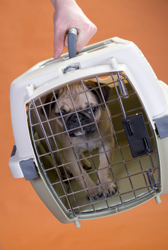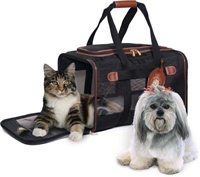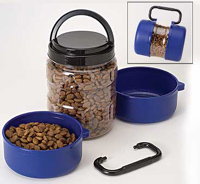By Deirdre Chiaramonte, DVM, DACVIM, The Animal Medical Center The key to successful international travel is to start planning early. First, review the pet policies of your foreign destination and call the consulate at least a year in advance to determine what vaccinations, blood tests and paperwork are required for your pet to successfully enter a foreign country. Regulations change unexpectedly and you should check with the consulate frequently to prevent a last minute rule change from thwarting your carefully planned trip.
The key to successful international travel is to start planning early. First, review the pet policies of your foreign destination and call the consulate at least a year in advance to determine what vaccinations, blood tests and paperwork are required for your pet to successfully enter a foreign country. Regulations change unexpectedly and you should check with the consulate frequently to prevent a last minute rule change from thwarting your carefully planned trip.
For example, prior to 2002, travel to the United Kingdom was prohibited unless your dog was quarantined for 6 months! Quarantine is no longer required, but travelers should anticipate an involved process requiring multiple trips to the vet for vaccinations, blood tests, microchips and deworming. A useful website for UK travel information is http://www.defra.gov.uk/animalh/quarantine/index.htm. There is also a helpful brochure to download called “Protecting the welfare of pet dogs and cats during journeys.â€Â
If you are thinking of traveling to a different hemisphere, there may be other requirements. For example, if you are traveling to Australia you need to apply for an AQIS import permit. Additionally, many countries use a ‘Pet Passport’ to facilitate pet travel. For more information, visit http://ec.europa.eu/food/animal/liveanimals/pets/qanda_en.htm.
Which pets should travel?
Not all pets should travel internationally. It is much safer if your dog or cat can travel under seat with you than in cargo for those long transoceanic flights. Besides geriatric dogs and dogs with chronic diseases – brachycephalic dogs, dogs with behavior issues (separation anxiety) and dogs with arthritis (staying in same position for long hours is hard on joints), also epileptic dogs should not travel in cargo.
How to get there?
If traveling by sea, some ships have kennels, but most do not permit pets in the staterooms. Airline websites usually have their own section on pet travel rules and regulations and these sites will detail what crates they will approve for travel. Choose direct flights if possible and try to avoid the hottest or coldest part of the day to travel.
 Label the crate (in English and the native language of the country to which you are traveling) with all identification and medical information in case you are separated from your pet due to unforeseen circumstances. Secure a photo of the pet to the crate, a copy of the medical record and some of the pet’s food so airline personnel can feed your pet in the event of an emergency. A large sticker saying LIVE ANIMALS should be placed on the crate as well. Animals should be familiar, comfortable and acclimated in their crates long before embarking on a trip. Supply your pet with a non-spill bowl for water inside the crate and line the bottom of the crate with absorbent paper.
Label the crate (in English and the native language of the country to which you are traveling) with all identification and medical information in case you are separated from your pet due to unforeseen circumstances. Secure a photo of the pet to the crate, a copy of the medical record and some of the pet’s food so airline personnel can feed your pet in the event of an emergency. A large sticker saying LIVE ANIMALS should be placed on the crate as well. Animals should be familiar, comfortable and acclimated in their crates long before embarking on a trip. Supply your pet with a non-spill bowl for water inside the crate and line the bottom of the crate with absorbent paper.
On the day of travel, feed only a light meal a few hours before departing. Water can be frozen so it will thaw slowly and spill less or you can teach your pet to drink from a special water dispensing bottle attached to the inside of the crate. Veterinarians at The Animal Medical Center do not recommend sedatives due to possible adverse reactions and inability to react to certain situations such as take-off and landing.
Research Required
Once you have determined the travel regulations for your pet, the real research begins. You need to find pet-friendly hotels and a veterinarian who can handle emergencies at your destination. You will also need to plan for any changes in weather might affect your pet as well as determine the pooper-scooper laws at your destination.
Carry health and vaccine records, extra food, medication refills and extra copies of paper prescriptions, microchip information, extra leashes and collars and photos of the pet. You may elect to purchase a personal microchip reader to facilitate entry through customs.
Helpful websites:
www.pettravel.com
www.pettravelcenter.com
www.aphis.usda.gov
You may want to seek additional advice about international travel from a USDA accredited veterinarian. Ask your veterinarian if they hold this certification. If not, you may contact The Animal Medical Center for assistance. To make an appointment at The AMC, please call 212 838-7053.
____________________________________
For nearly a century, The Animal Medical Center has been a national leader in animal health care, known for its expertise, innovation and success in providing routine, specialty and emergency medical care for companion animals. Thanks in part to the enduring generosity of donors, The AMC is also known for its outstanding teaching, research and compassionate community funds. Please help us to continue these efforts. Send your contribution to: The Animal Medical Center 510 East 62nd Street, New York, NY 10065. For more information, visit www.amcny.org. To make an appointment, please call 212.838.7053.
To quote George Gershwin, “Summertime and the livin’ is easy,†but travelin’ with your pet requires more than just hopping in the car with your furry family member and heading off on a road trip. Here are some tips about travel for the pet-owning family.
Which pets should travel? Travel is not for every pet. If you are going to be gone only a few days or less, it maybe better for your pet to stay home with a pet sitter, especially if you have a large dog and the trip involves air travel as cargo. (Read more on air travel in the “How to get there†section.) Geriatric animals may not be the best travelers either. Just like grandma, changes in schedule, water and nap time may not be the older pet’s idea of fun. Pets with chronic health conditions such as kidney disease or heart disease may decompensate from travel stress, so check with your veterinarian about the feasibility of traveling with your older pet.
Travel is not for every pet. If you are going to be gone only a few days or less, it maybe better for your pet to stay home with a pet sitter, especially if you have a large dog and the trip involves air travel as cargo. (Read more on air travel in the “How to get there†section.) Geriatric animals may not be the best travelers either. Just like grandma, changes in schedule, water and nap time may not be the older pet’s idea of fun. Pets with chronic health conditions such as kidney disease or heart disease may decompensate from travel stress, so check with your veterinarian about the feasibility of traveling with your older pet.
How to get there
Pet owners are limited to travel by car or airplane since long distance trains and buses typically do not allow pets. Local buses and trains may allow small pets if they are confined in a carrier.
Car – If you are traveling by car, your pet needs to be restrained to protect your pet if you stop quickly and to protect you from being distracted by their antics. Seatbelts can attach to a special harness or you can use the existing seatbelts to curtail any movements of the pet carrier during quick stops.
 Air – An excellent resource for the pet owner planning an airline trip is PetFlight.com. This site has travel tips, airline information and travel alerts. Each airline has its own rules about pets on flights, so be sure to check with your carrier well before your planned trip. Make sure your pet and its carrier meet the airline’ regulations, and you have the appropriate travel certificate from your veterinarian.
Air – An excellent resource for the pet owner planning an airline trip is PetFlight.com. This site has travel tips, airline information and travel alerts. Each airline has its own rules about pets on flights, so be sure to check with your carrier well before your planned trip. Make sure your pet and its carrier meet the airline’ regulations, and you have the appropriate travel certificate from your veterinarian.
New to the world of pet travel is Pet Airways the only airline focused on transporting your pet as a passenger, not as cargo. The airline launched July 14, with flights between New York, Denver, Los Angles, Chicago and Washington, D.C.
What to pack Although bulky, taking your pet’s regular food is likely to prevent a serious case of stomach upset and save you from having to find an emergency clinic and a new source of your pet’s regular food. Abrupt changes in food often set off a bout of vomiting and diarrhea. Litter is bulky too, but a necessity if you are traveling with a cat. Be sure to carry a copy of your pet’s most recent vaccinations. If your pet has health problems, ask your veterinarian for a summary letter explaining your pet’s condition in case you need veterinary care when your regular veterinarian’s office is closed. Be sure the letter lists your pet’s current prescriptions and most recent blood test results.
Although bulky, taking your pet’s regular food is likely to prevent a serious case of stomach upset and save you from having to find an emergency clinic and a new source of your pet’s regular food. Abrupt changes in food often set off a bout of vomiting and diarrhea. Litter is bulky too, but a necessity if you are traveling with a cat. Be sure to carry a copy of your pet’s most recent vaccinations. If your pet has health problems, ask your veterinarian for a summary letter explaining your pet’s condition in case you need veterinary care when your regular veterinarian’s office is closed. Be sure the letter lists your pet’s current prescriptions and most recent blood test results.
In addition to packing your pet’s medical information and food and bowls, you need to pack a leash/harness/collar and a backup set all with current ID tags. If your pet has not been microchipped, have your veterinarian implant one so your pet can be identified if it slips its collar.
If you will be staying in one location for more than a week, you might want to ask your veterinarian for a recommendation of a veterinarian in that area. You could also identify a veterinarian using the American Animal Hospital Association’s accredited hospital locator. Finding a veterinarian in advance will save time in an emergency.
Where to stay: finding a pet friendly hotel The American Automobile Association has an advanced hotel option which allows you to search for hotels which allow pets. The website DogFriendly.com is also a good resource for all things dog friendly. If national parks are your destination this year, the website www.nps.gov can serve as your resource guide for parks and park lodging friendly to your pet.
The American Automobile Association has an advanced hotel option which allows you to search for hotels which allow pets. The website DogFriendly.com is also a good resource for all things dog friendly. If national parks are your destination this year, the website www.nps.gov can serve as your resource guide for parks and park lodging friendly to your pet.
Always follow good “petiquette†when staying in hotels with your pet. Cover the furniture with a sheet or blanket to protect it from hair. Crate your pet if you leave it alone in the hotel room while dining out and put the “do not disturb†sign on the door so hotel staff will not inadvertently open the door and let your pet escape. When walking your pet, keep away from the building and be sure to pack enough plastic bags to properly dispose of waste. Cats present a different set of problems in a hotel room. Picture yourself trying to get your “scaredy†cat out from underneath the hotel bed. Cats might be better confined in the hotel bathroom or in their travel crate.
While traveling with a pet may present some challenges, being well prepared can help to alleviate stress on you and your pet. ______________________________
For nearly a century, The Animal Medical Center has been a national leader in animal health care, known for its expertise, innovation and success in providing routine, specialty and emergency medical care for companion animals. Thanks in part to the enduring generosity of donors, The AMC is also known for its outstanding teaching, research and compassionate community funds. Please help us to continue these efforts. Send your contribution to: The Animal Medical Center 510 East 62nd Street, New York, NY 10065. For more information, visit www.amcny.org.
No comments:
Post a Comment